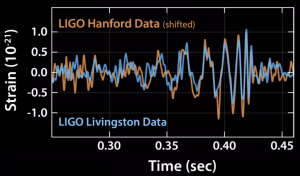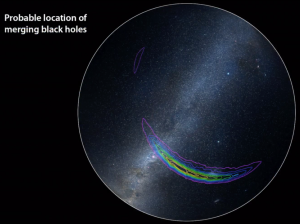Peter Lobner
Today, 11 February 2016, the National Science Foundation (NSF) and the Laser Interferometer Gravitational-Wave Observatory (LIGO) project team announced that the first detection of gravitational waves occurred on 14 September 2015. You can view a video of this announcement at the following link:
https://www.youtube.com/watch?v=_582rU6neLc
The first paper on this milestone event, “Observation of Gravitational Waves From a Binary Black Hole Merger,” is reported in Physical Review Letters, at the following link:
http://journals.aps.org/prl/pdf/10.1103/PhysRevLett.116.061102
The recorded signals from the two LIGO sites, Livingston, LA and Hanford, WA, are shown below, with the Hanford data time shifted to account for the slightly later arrival time of the gravitational wave signal at that detector location. The magnitude of the gravitational wave signal was characterized as being just below the detection threshold of LIGO before installation of the new advanced detectors, which improve LIGO sensitivity by a factor of 3 to 10.
Source: NSF/LIGO
This milestone occurred during the engineering testing phase of the advanced LIGO detectors, before the start of their first official “observing run” on 18 September 2015.
Analysis and simulations conducted on the data indicate that the observed gravitational wave signals were generated when two orbiting black holes coalesced into a single black hole of smaller total mass and ejected about three solar masses of energy as gravitational waves.
In the Physical Review Letters paper, the authors provide the following diagram, which gives a physical interpretation of the observed gravitational wave signals.
Note the very short timescale of this extraordinarily dynamic process. The recorded gravitational wave signals yielded an audible “chirp” when the two black holes merged.
With only two LIGO detectors, the source of the observed gravitational waves could not be localized, but the LIGO team reported that the source was in the southern sky, most likely in the vicinity of the Magellanic Clouds.
The ability to localize gravitational wave signals will improve when additional gravitational wave detectors become operational later in this decade.
For more information on the current status of LIGO and other new-generation gravitational wave detectors, see my 16 December 2015 post: “100th Anniversary of Einstein’s Theory of General Relativity and the Advent of a New Generation of Gravity Wave Detectors.”
Update: 3 October 2017
Congratulations to Rainer Weiss, Barry C. Barish, and Kip S. Thorne, all members of the LIGO / VIRGO Collaboration, for their award of the 2017 Nobel Prize in Physics for the first direct observation of gravitational waves. You can read the press release from the Royal Swedish Academy of Sciences here:
https://www.nobelprize.org/nobel_prizes/physics/laureates/2017/press.html
You also can read the scientific background on this award on the Royal Swedish Academy of Sciences website at the following link:
https://www.nobelprize.org/nobel_prizes/physics/laureates/2017/advanced-physicsprize2017.pdf


